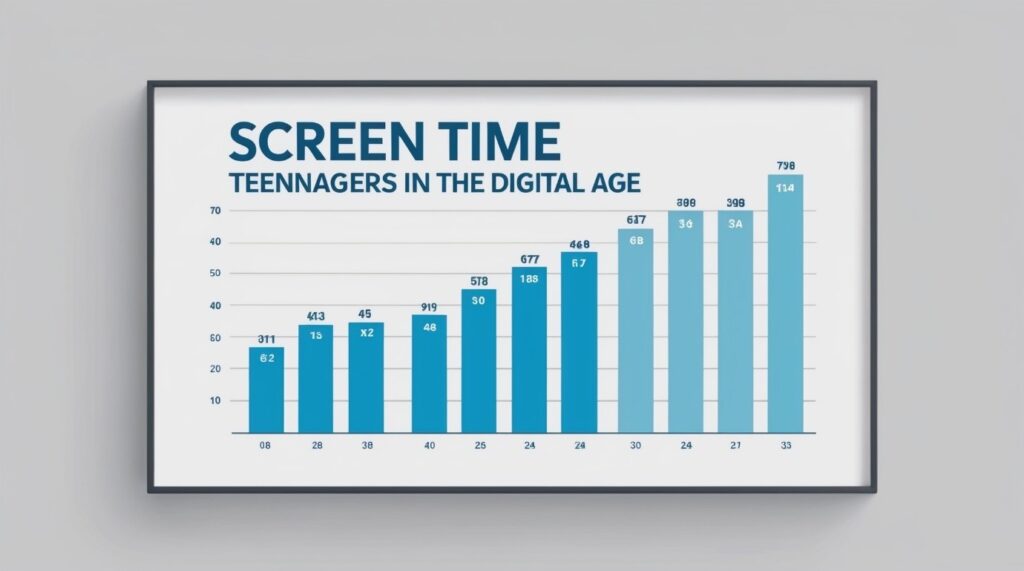How to Create a Technology Contract for Teens
Parenting in the digital age can sometimes feel like balancing on a tightrope. On one hand, you want your teen to have access to the digital tools needed for learning and socializing; on the other, you face challenges such as excessive screen time, distractions, and online pitfalls. If you find yourself repeatedly saying, “Put your phone down!” without much change, it might be time to try a fresh approach. In this guide, we’ll show you how to create a technology contract for teens that can empower your family to set clear boundaries, establish expectations, and ease conflicts over tech use.

Parent signing technology contract with children
Parent Testimonial
“Before we signed our tech contract, I felt like a broken record, constantly reminding my 14-year-old about his screen time. Now, we have a system in place where everyone knows the rules. We’re communicating better, and I no longer have to be the tech police.”
— Jessica, mother of two teens.
Why Your Teen Needs a Technology Contract
The Digital Landscape for Teens Today
Modern teens live in a world where technology is always at hand. For instance, studies reveal that:
- Firstly, 95% of teens have access to a smartphone, making it a staple in their daily lives.
- Secondly, the average teen spends about 7 hours and 22 minutes on screens each day.
- Additonaly, nearly 45% of teens say they are online almost all the time.
In addition, unchecked screen time can lead to issues such as disrupted sleep, poor posture, and reduced physical activity. Consequently, these problems can also strain family relationships. Dr. Emma Screentime, a pediatric technology researcher, notes that excessive use of screens may replace valuable face-to-face interactions and hinder emotional growth.

Statistics show that teens spend a significant amount of time on screens, often more than sleeping or engaging in face-to-face communication.
Why Create a Technology Contract for Teens?
Creating a tech contract might seem unnecessary at first, but it’s essential for setting clear boundaries and fostering mutual respect between parents and teens. A contract helps establish a framework for what is and isn’t acceptable when it comes to technology use, ensuring that expectations are communicated and agreed upon by everyone.
The Value of a Technology Contract
Although a technology contract might seem unnecessary at first glance, it plays an essential role in setting clear guidelines and building mutual respect between parents and teens. By taking the time to Create a Technology Contract for Teens, families can establish clear expectations, ensuring that everyone understands and agrees on what is acceptable. This proactive approach helps reduce daily conflicts over tech use and fosters a healthier digital environment at home.
The Benefits You Can Expect
A well-thought-out tech contract offers several advantages:
- Clear Boundaries: This section defines when and where devices are allowed, cutting down on repetitive reminders.
- Responsibility Training: Teens learn that tech privileges come with real-world responsibilities.
- Enhanced Communication: Families gain opportunities to discuss online safety and balanced tech use.
- Reduced Conflicts: Rules supported by everyone foster a harmonious home environment.
How to Create a Technology Contract That Works
Step 1: Start with an Open Family Discussion
Begin by including your teen in the conversation. Organize a relaxed family meeting—perhaps over dinner or a casual gathering—to discuss why balanced technology use is important. Invite your teen to share thoughts and concerns, which can help build trust and improve cooperation. Moreover, by focusing on collaboration rather than confrontation, you’re more likely to Create a Technology Contract that everyone respects.
Pro Tip: Focus on collaboration, not confrontation. Highlight the benefits of balanced tech use, like better sleep, less stress, and more quality family time.

A family meeting over pizza to discuss and set boundaries for tech use can help promote cooperation.
Step 2: Define Rules for Technology Use
Together, decide on basic guidelines for using technology. You might consider the following points:
A. Establish Screen-Free Times
Agree on specific times when devices should be off-limits. For example:
- During family meals
- One hour before bedtime
- While doing homework or studying
B. Create Tech-Free Zones
Identify areas in your home where devices are not allowed. Common zones include:
- Bedrooms
- The dining table
- Bathrooms
C. Set Guidelines for Apps and Games
Since not all apps or games are suitable for every teen, work together to decide which ones are acceptable. It’s a good idea to review these choices periodically as your teen grows.
Parent Tip:
Consider implementing a “No-Phone Zone” during dinner. Violators of this zone might be required to do the dishes—a simple but effective incentive.
Step 3: Set Screen Time Limits
Compromise is key when setting screen time boundaries. Use this table as a guide:
|
Scenario |
Teen’s Wish |
Parent’s Wish |
Compromise |
|
Weekdays |
“All day, every day” |
“Only after chores and homework |
2 hours after chores and homework |
|
Weekends |
“What’s sleep?” |
“Family time and chores first” |
4 hours, with breaks for family activities |
|
Bedtime |
“Phones need company” |
“Phones sleep in the kitchen” |
Phones out 1 hour before sleep |
|
Dinner Time |
“Important meme incoming!” |
“Actual human interaction” |
Phones in a basket during meals |
In addition, such a schedule helps set clear expectations while teaching responsible behavior.
Parent Testimonial
“We implemented screen-free zones and times, and the difference is night and day. Dinner has become a time for real conversations.”
— Sarah, mother of two teens.
Step 4: Address Online Safety
Online safety is crucial, so be sure to include these elements in your contract:
A. Protect Personal Privacy
Teach your teen to safeguard personal information and avoid sharing sensitive details online.
B. Establish Social Media Guidelines
Discuss the long-lasting impact of social media posts and encourage thoughtful sharing.
C. Address Stranger Danger
Explain the risks of interacting with strangers online, and agree on a balanced approach to monitoring.
For instance, cybersecurity expert Jane Firewall advises, “Treat your personal information online like cash,” underscoring the need to protect valuable data.
Expert Tip: Jane Firewall, a cybersecurity expert, says, “Think of personal information online as cash. Treat it as valuable and protect it.”

Setting guidelines for online privacy and social media use can help protect teens in the digital world.
Expert Tip:
Cybersecurity expert Jane Firewall emphasizes, “Treat your personal information online like cash. It’s valuable and should be guarded carefully.”
Step 5: Link Privileges to Responsibilities
One effective strategy is to tie tech privileges to everyday responsibilities. Consider a system like this:
|
Responsibility |
Reward |
Consequence |
|
Completed Homework |
+30 minutes of screen time |
-30 minutes f oscreen time |
|
Chores Done |
+1-hour weekend screen time |
No weekend gaming |
|
Respectful Online behaviour |
Increased Trust and Privacy |
More monitoring |
|
Damaged Device |
Reapair cost deducted from allowance |
Loss of tech priviledges |
This approach fosters responsibility while helping teens understand the connection between actions and outcomes.
Step 6: Balance Family Time and Technology
It’s important to remember that family time is just as valuable as digital time. To achieve this, consider:
Creating Fun Challenges: For instance, organize a “Longest Without Checking Phone” contest during dinner, where the winner picks the next family movie. Small challenges like this can make technology boundaries more engaging and fun. For more insights, check out our guide: Parenting and Financial Improvement: How to Manage Your Finances While Raising Kids.
Learn how to balance your financial goals with the demands of parenting in our guide: Parenting and Financial Improvement: How to Manage Your Finances While Raising Kids.”
Fun Challenge: Have a “Longest Without Checking Phone” contest during family game night. The winner picks the next movie for family movie night!
Step 7: Promote Physical and Mental Health
Don’t overlook the impact of technology on well-being. Try these tips:
- Reduce Nighttime Device Use: Limit blue light exposure before bed to improve sleep quality.
- Emphasize Ergonomics: Remind your teen about proper posture to avoid issues like “tech neck.”
- Encourage Regular Exercise: Ensure there’s time for daily physical activity to balance sedentary screen time.
Additionally, simple investments such as blue light glasses or ergonomic chairs can further support healthier habits.
Want to explore more tips for balancing screen time with physical activities? Check out our guide on Balancing Online and Offline Activities: Tips for Families.
Fun Challenge: Have a “Longest Without Checking Phone” contest during family game night. The winner picks the next movie for family movie night!
Step 8: Review and Revise the Contract Regularly
As your teen grows and technology evolves, so should your contract. By committing to Create a Technology Contract for Teens, you establish a framework that can adapt over time. Schedule regular family meetings to review the agreement, adjust the rules as needed, and ensure it stays aligned with your teen’s needs and digital habits. Celebrating successes and staying flexible will help keep the contract relevant and effective.
Conclusion: A Collaborative Approach to Technology Use
In summary, a technology contract is not about control but about building trust, teaching responsibility, and promoting a balanced approach to digital life. When you Create a Technology Contract for Teens, you empower your teen by involving them in the process, setting guidelines that respect their independence while encouraging healthy tech habits. Take the first step by drafting your family’s tech contract and reviewing it together. In doing so, you create a foundation for responsible technology use that will benefit your family well into the future.
Parent Testimonial:
“Our family tech contract has been a game-changer. The kids are more responsible, and family time has become more meaningful.”
– Claire, mother of three teens
Embrace this collaborative approach and start crafting a contract that works for everyone today!

